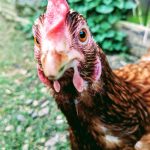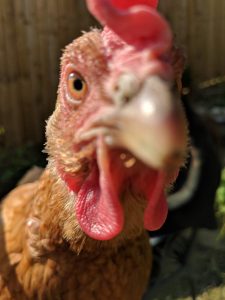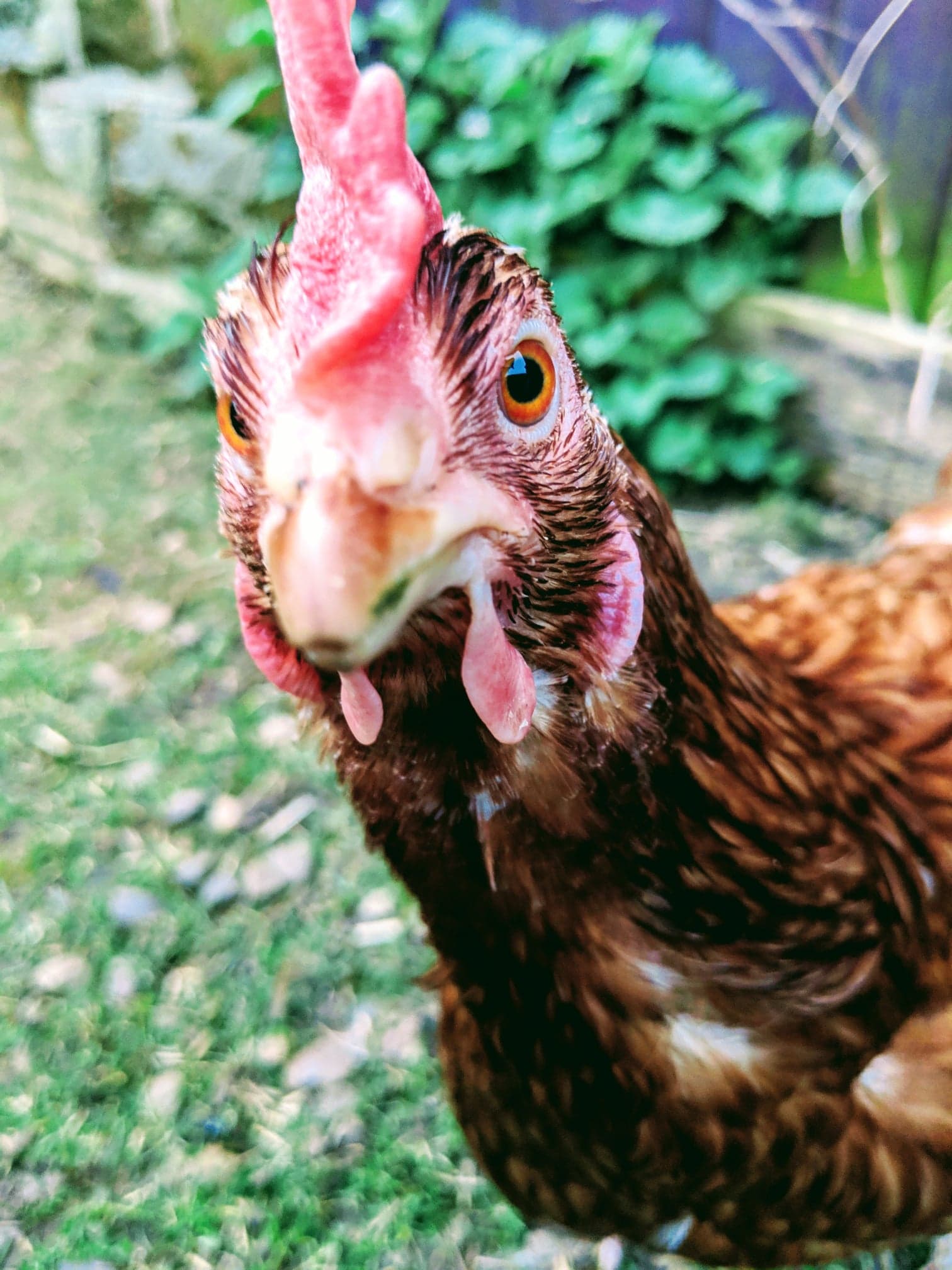
Rita and Joan arrived via the re-homing charity Fresh Start for Hens. The hens come from different commercial egg production systems, intensive to free range, but they are usually in a fairly ragged state regardless and are up for grabs because they have reached the end of their so-called productive life.
Without the intervention of FSFH, and other similar charities (who pay the farmers to take the hens off their hands) these chickens would simply go to slaughter, ending up in pies, pasties and pet food – all because they don’t lay quite as many eggs after 18 months of age. (Backyard birds often live beyond five years old and apparently the oldest recorded hen made it to 16!)
The Other White House’s journey began when we saw an advert in a local village newsletter in early autumn and contacted the charity to ‘book’ our girls. We made a small donation for each hen and sent pictures of our coop and garden set-up, complete with photo-bombing bantams, to prove the girls were going to a good home.
Then it was a matter of waiting.
We received our re-homing details at the end of November and on the first Saturday in December set off to collect our ladies from our local pick-up point. These are, essentially, the homes of FSFH volunteers, who help to collect the hens from the farm and transport them back, ready for their new owners to come and get them.
At the appointed time and armed with a large cardboard box, strewn with straw and punctured with air holes, we travelled the few miles to the next-but-one village to meet our girls. FSFH usually recommends taking a minimum of three birds, but as we already had three (and a very ordinary sized garden) we had agreed on two.
Rescue hens are typically ‘ranger’ types, these had red-brown feathers – although Joan had a bald head and bum – and beady orange eyes! G helped to choose and catch ‘our’ two as the other (I would estimate) 50 hens ran hither and thither across the stable floor bokking loudly. In the meantime, several further sets of prospective owners had arrived, waiting patiently with their boxes, and in a matter of minutes we were on our way home, quiet clucking coming from the car boot.
New hens need to be introduced to each other slowly and gently. You can’t just go chucking them in there and hoping they’ll all get on. There’s something called the ‘pecking order’, which needs to be re-arranged when there are changes to the flock, so that every hen knows its place. (You’d be surprised at the number of people who are familiar with the term ‘pecking order’ but don’t realise it’s a ‘thing’!)
We had already fenced off part of the garden with a rudimentary construction of chicken wire and a rake-handle gate and plopped Rita and Joan into their new enclosure, complete with mini hen house. The bantams – Audrey, Greta and Clarence – had the rest of the garden and their usual Eglu Go Up. This meant the birds could see (and smell) and hear each other, but no more.
The hens were kept like this for three weeks in total (Rita proved to be a bit of a Steve McQueen, jumping the fence on several occasions during the last week of separation!) and during that time we got to know our new ladies a little better; gaining a new appreciation of just how inquisitive and engaging these animals are.
Far less skittish than our little birds, we soon learned that Rita and Joan loved hoo-man company; chatting away whenever we entered their enclosure, pecking at feet and shoelaces and interested in everything that might possibly be food. We had no real issues with their feed (some rescue hens are unable to eat layers’ pellets, because they are used to a mash) and the eggs soon started to arrive.
We mingled them just before Christmas and barring the odd scrap (fighting was deterred with a squirt of water from a plant-sprayer) it was relatively painless – for them and for us. No flying feathers or blood drawn. The pecking order was established as: Clarence, Rita, Audrey, Greta and Joan and it remains that way.
There have been a couple of interesting moments since. Like discovering 10 Joan eggs hidden at the foot of a honeysuckle …
The FSFH forum is filled with tales of soft-shelled, ‘wind’ and ‘fairy’ eggs and rescues that never really get going with the egg thing at all, so we just assumed she’d stopped for the winter, and maybe even forever.
What we didn’t realise was that the pecking order was playing out in terms of who could lay their eggs where, and poor Joan – on the bottom rung – had been made to find somewhere else to lay hers. She still uses her hidey-hole; Rita and the little girls take turns in the Eglu (although Audrey will shout at the doorway, demanding a scattering of Fresh Bed, if the cleanliness of the nest box isn’t up to her usual high standards!)
Then there was the time Rita gave us a scare …
It was clear the bigger of our two new girls was under the weather: head tucked into her neck feathers, rear end low, like she was ‘bearing down’, keeping away from the others.

Chickens are notoriously good at hiding illness and injury. Indeed, our chicken ‘bible’ Chicken and Eggs by Mark Diacono, one of a series of River Cottage handbooks, says the first sign anything is wrong with a bird can often be its legs sticking up in the air! So, these signals were appreciated, but we needed to find out what was wrong with our Rita.
Thinking she might be egg-bound, we brought her into the house for the equivalent of a chicken spa – a warm bath with Epsom Salts and a blow dry. She really seemed to enjoy it, snuggling up into my cardigan as Mat gently dried her feathers. We noticed she too was a bit bald around the nether regions – and eventually this was the clue as to what was wrong.
A visit to the vet to double-check revealed nothing more than a full crop, not sour – a condition chickens can suffer from when food gets stuck and sort of ferments in there – and a big, but not problematic, egg en route.
With no obvious issues we returned Rita to the flock and she promptly lost a pillow-full of feathers – leading us to believe that what had been getting her down was an impending moult, where hens shed and re-grow their feathers, and which can be very tiring for them.
A couple of weeks later she was unrecognisable: golden and gorgeous. Joan joined in as well and sprouted a fine new head of ‘hair’ to accompany her existing and slightly alarming eyebrows, which resemble those of the Hollywood icon behind her name …
Joan is an independent spirit, which probably has more to do with her lowly position in the pecking order than any real sense of autonomy, and she is always trying to get into the house. The mere rattle of the handle sends her running from wherever she’s hiding in the garden to the back door, where treats are dispensed. Rita is a bigger hen and a bigger personality, giving Clarence the cockerel a run for his money at the head of the order.
We absolutely love our new ladies. They are funny, clever, entertaining and each provide us with a gratefully-received (we always say thank you) egg almost every day.
And for clucks’ sake
If you’re going to eat chicken – and we don’t – then please, please do these amazing animals the honour of consuming every last bit, because they give up a lot to provide us with food and it’s only right after all.
According to WRAP, the UK wastes the equivalent of three uneaten chickens every second. Or 86 million of these wonderful, intelligent, friendly creatures every year. It’s heart-breaking.
If you’re going to eat eggs then buy the best you can: organic and free range, which means the hens have had at least a half-decent life. If you’ve neighbours like us with a small flock, buy from them instead.
For top tips and handy hints to make the most of this meat, visit these Love Food Hate Waste pages:
Store chicken the right way
Six ways to use leftover chicken
For information about Fresh Start for Hens, visit: https://freshstartforhens.co.uk/

